The Enduring Legacy of Mortuary Craftsmanship
An antique porcelain embalming table represents a fascinating intersection of medical history, craftsmanship, and funeral tradition. These remarkable pieces served as the workstation for embalmers from the late 19th century through the mid-20th century, when preparing the deceased was transitioning from a family ritual to a professional service.
What made these tables special wasn't just their purpose but their thoughtful design. The gleaming porcelain surface wasn't merely for appearance—it provided a non-porous, chemical-resistant workspace that could be thoroughly sanitized between uses. Beneath this practical surface, a sturdy cast iron base offered the stability needed for delicate procedures. Many models featured ingenious hydraulic lift systems that allowed morticians to work at comfortable heights, reducing physical strain during long preparations.
| Feature | Purpose |
|---|---|
| Porcelain surface | Non-porous, easy to clean, resistant to stains and chemicals |
| Cast iron base | Provided stability and structural support |
| Hydraulic lift | Allowed height adjustment for mortician comfort |
| Drainage channels | Directed fluids to collection points |
| Modular design | Some tables separated into pieces for transport |
These tables marked a significant step forward from the simple wooden "cooling boards" of the Victorian era. While today's funeral homes primarily use stainless steel equipment, the charm and historical significance of antique porcelain embalming tables have created a dedicated collecting community. Museums seek them for medical history exhibits, while designers incorporate them into unique interiors after thoughtful restoration.
The market for these pieces reflects their rarity and craftsmanship, with basic models starting around $800, while pristine examples from renowned makers like Royal Doulton or Dodge Chemical Co. can command $3,000 or more at specialist auctions.
I'm Mortuary Cooler, and I've spent years supplying modern mortuary equipment while developing a deep appreciation for these historical pieces. Working in the funeral industry has given me a unique perspective on both the practical considerations and cultural significance of these remarkable artifacts—they're not just antiques, but tangible connections to how we've honored our deceased throughout American history.
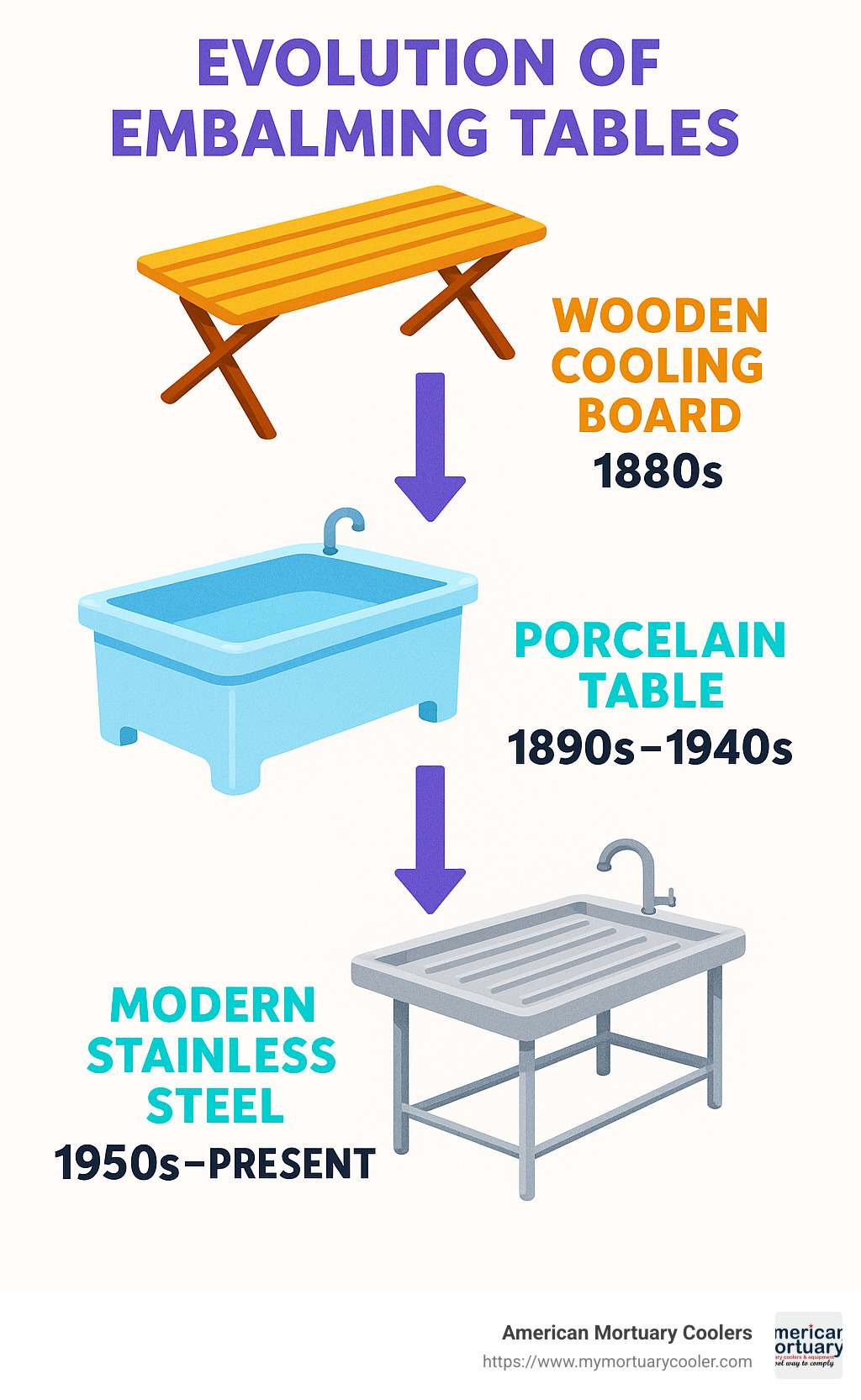
If you're new to exploring antique porcelain embalming tables, here are some helpful terms you might encounter:
- embalming table definition - understanding the basic purpose and design
- autopsy table - similar but designed for different purposes
- preparation room funeral home - where these tables were typically used
What Is an Antique Porcelain Embalming Table?
The antique porcelain embalming table represents a fascinating chapter in funeral history. These specialized pieces of mortuary equipment dominated the industry from the 1890s through the 1940s, revolutionizing how funeral professionals cared for the deceased.
Think of these tables as the workbench where funeral directors practiced their craft. Unlike earlier wooden tables, the porcelain surface offered something genuinely for its time – a completely non-porous surface that resisted staining and contamination. This was a huge leap forward when germ theory was still relatively new in public health.
"The porcelain surface changed everything for funeral professionals," as mortuary historian Dr. Michael Echols explains. "It brought modern sanitation standards to a profession that desperately needed them."
What made these tables instantly recognizable was their thoughtful design. The slightly concave surface with carefully engineered drainage channels guided fluids toward brass drains. The gleaming white porcelain top contrasted beautifully with ornate cast iron bases, blending Victorian craftsmanship with practical functionality.
| Material | Advantages | Disadvantages | Period of Use |
|---|---|---|---|
| Wood | Lightweight, inexpensive, portable | Absorbed fluids, difficult to sanitize, warped over time | Pre-1890s |
| Porcelain | Non-porous, chemical-resistant, durable, easy to clean | Heavy, breakable, expensive | 1890s-1940s |
| Stainless Steel | Lightweight, durable, non-porous, modern appearance | Lacked vintage aesthetic, could dent | 1950s-Present |
Anatomy of an Antique Porcelain Embalming Table
Every antique porcelain embalming table tells a story through its construction. The heavy cast-iron base did more than just provide stability – it often showcased the artistic sensibilities of the era, with Victorian flourishes or streamlined Art Deco styling depending on when it was manufactured.
The defining feature, of course, was that gleaming porcelain top. This wasn't your grandmother's china – this specialized industrial porcelain was fired at extreme temperatures to create a glass-like surface permanently bonded to the metal underneath. The result was practically indestructible under normal use and resisted everything from formaldehyde to phenol.
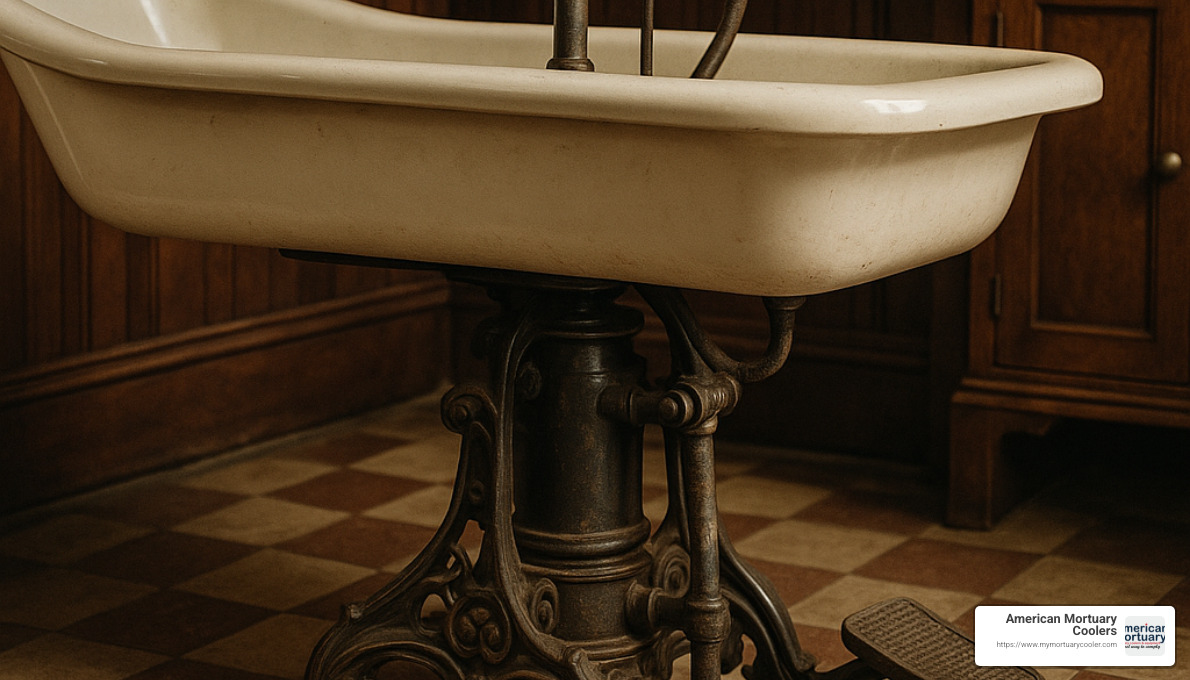
More sophisticated models featured hydraulic lift systems operated by foot pedals, allowing morticians to adjust the height while keeping their hands free for their delicate work. These engineering marvels represented cutting-edge technology for their time.
Many tables from prestigious makers featured decorative claw-foot designs that weren't just beautiful – they provided a wider, more stable footprint. Function and form worked together seamlessly in these pieces.
Here at American Mortuary Coolers, we once encountered a fascinating Royal Doulton model from around 1925 that was built in three separate pieces. This modular design allowed funeral directors to transport their equipment more easily when traveling to homes for embalming services.
How an Antique Porcelain Embalming Table Was Used
To truly understand these remarkable pieces, we need to consider how they were used in practice. Before the standardization of funeral homes, many embalmings took place in the deceased's home. Portable embalming tables were designed with this reality in mind.
During a typical procedure, the funeral director would position the table with its drainage outlets aligned over collection receptacles. After sanitizing the porcelain surface, they would position the body with the head slightly liftd. The embalming process would begin, with the table's drainage system efficiently collecting fluids.
The value of porcelain became immediately apparent during use. As one 1910 mortuary supply catalog proudly stated: "Our porcelain tables resist the corrosive effects of modern embalming compounds, ensuring years of service while maintaining the highest standards of sanitation."
As funeral practices evolved, these antique porcelain embalming tables became fixtures in dedicated preparation rooms. By the 1920s, many states specifically required non-porous surfaces for embalming procedures, cementing porcelain's dominance until stainless steel emerged as a lighter alternative.
We've spoken with many retired embalmers who fondly recall the distinctive clear, resonant tone of instruments being placed on porcelain – a sound quite unlike the duller thud of modern stainless steel tables. These small sensory details connect us to the practical experiences of funeral professionals from a bygone era.
For more information about the purpose and use of these fascinating historical pieces, you might enjoy our in-depth article: More info about x services.
From Cooling Boards to Porcelain: A Brief History
The evolution of the antique porcelain embalming table tells a fascinating story about how Americans have changed their relationship with death, cleanliness, and the funeral profession itself. It's a journey that mirrors our society's broader change.
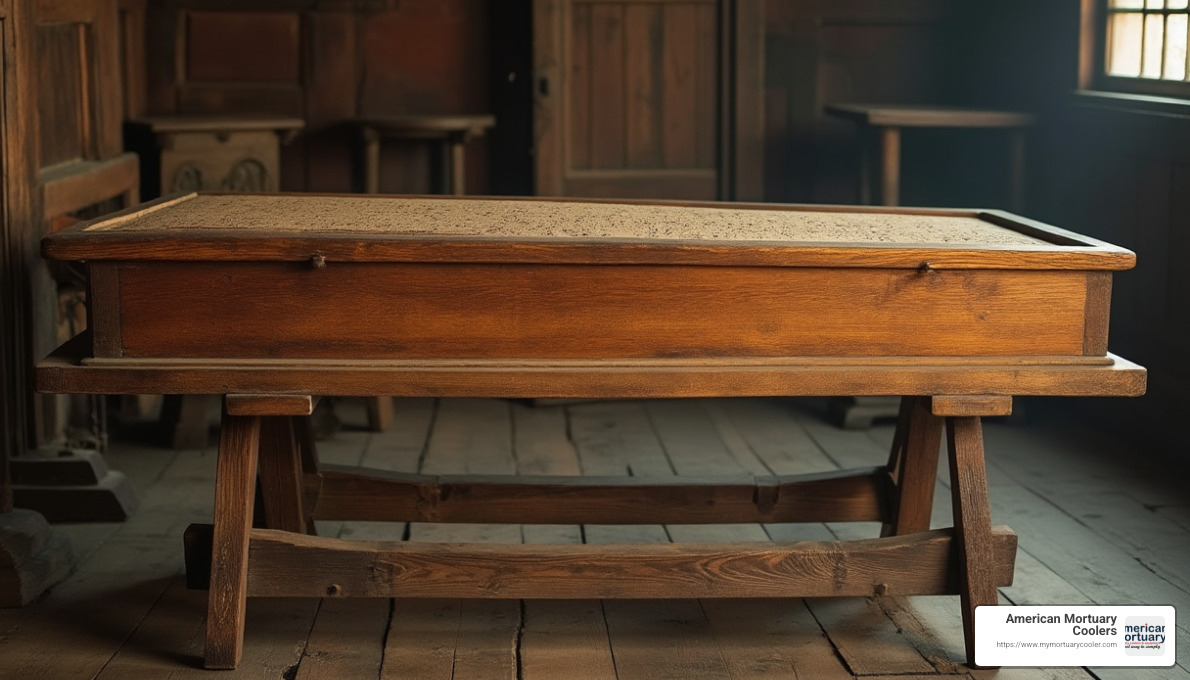
The Civil War marked a turning point in how we handled our deceased. With soldiers dying far from home, preservation became essential for bringing them back to their families. Early embalmers like Thomas Holmes often worked with whatever they could find – typically just a wooden door balanced across barrels. Not exactly high-tech, but it got the job done. These makeshift setups made it clear that funeral professionals needed better equipment.
After the war, wooden "cooling boards" became the standard tool of the trade. These simple boards often featured caned or drilled surfaces that allowed undertakers to place ice beneath the body. This cooling effect bought precious time by slowing decomposition. A craftsman named B.F. Gleason from Brockport, New York, became famous for his cooling boards in the 1880s. He introduced clever features like adjustable headrests and folding designs that made them easier to transport to homes for family funerals.
"Undertaker's cooling boards were workhorses from the 1880s through the 1940s," notes one historical account we've preserved in our archives at American Mortuary Coolers. "Many featured drilled or caned tops that allowed air to circulate around ice blocks." These boards served their purpose but had obvious limitations when it came to cleanliness and durability.
The big shift to porcelain began in earnest during the 1890s. This wasn't just a style change – it coincided with growing awareness about germs and sanitation. The earliest porcelain tables kept the basic design of cooling boards but swapped out absorbent wood for non-porous, easy-to-clean porcelain surfaces.
By the Roaring Twenties, even prestigious ceramics companies like Royal Doulton had entered the mortuary supply business. They produced beautiful, high-quality porcelain tables that were as functional as they were neat. A 1925 Royal Doulton catalog in our collection describes their embalming tables as "the pinnacle of modern mortuary science—combining unparalleled sanitation with dignified aesthetics." Not exactly modest, but they weren't wrong!
The 1930s brought further innovation from American companies like Dodge Chemical Co., who introduced improved hydraulic systems and clever drainage designs. These tables represented the absolute cutting edge of embalming technology for their era. Many funeral homes invested in these as showpieces that demonstrated their commitment to modern practices.
By the 1950s, a new material entered the scene: stainless steel. These newer tables offered similar sanitary benefits but were lighter, less fragile, and often less expensive. This shift marked the sunset of the golden age of porcelain embalming tables, changing them from everyday tools into sought-after antiques and collectibles.
At American Mortuary Coolers, we've carefully documented this evolution through our collection of historical catalogs, price lists, and equipment specifications. The journey from simple wooden cooling boards to sophisticated porcelain tables tells the story of how funeral service transformed from an informal practice into a regulated, respected profession.
Want to learn more about the historical context of these fascinating artifacts? Check out MEDICAL COLLECTING ALERTS-P. 2 for additional insights into the collecting of medical antiques.
Identifying and Evaluating Authentic Pieces
For collectors and historians interested in antique porcelain embalming tables, proper identification and authentication are crucial. The market unfortunately contains numerous misidentified pieces and outright reproductions.
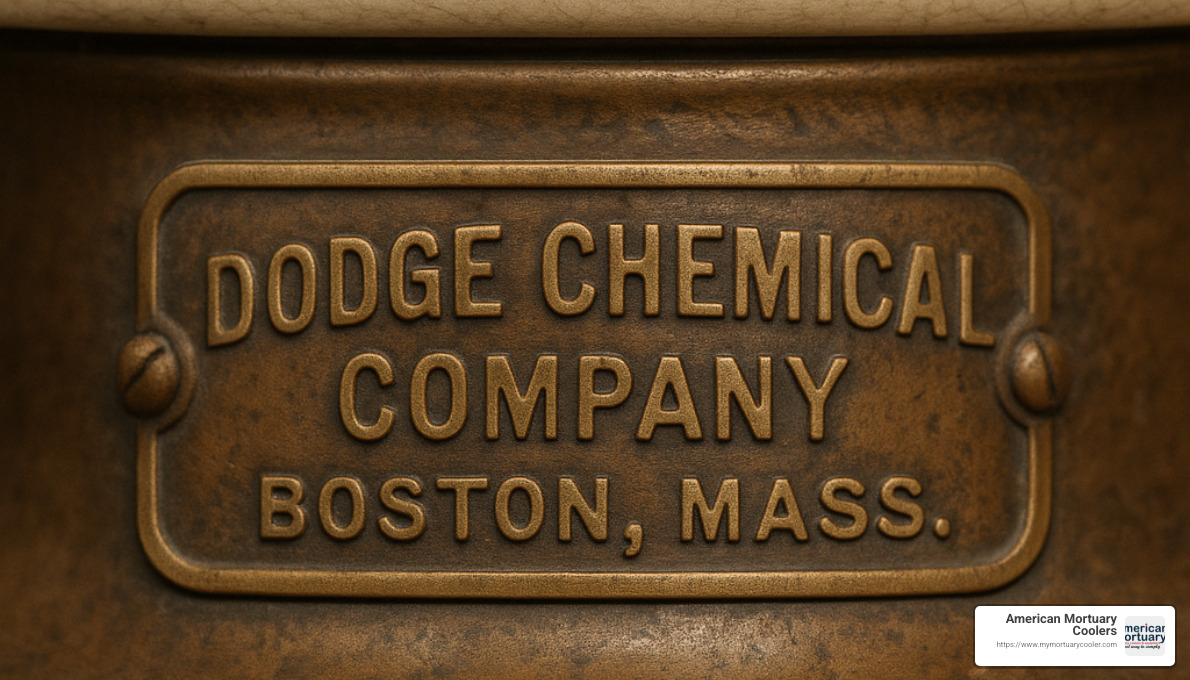
I remember a collector who once told me, "The brass provenance plaque completely overturned the dealer's misidentification. What had been sold as a 'military field bed' was revealed to be 'THE CLIMAX MADE BY THE ENTERPRISE MFG CO. COLUMBUS, OH'—a classic undertaker's table." This story highlights why knowing what to look for is so important.
Maker's Marks tell much of the story. Authentic tables typically bear manufacturer's marks, though these may be subtle or partially worn with age. Royal Doulton pieces often feature a small impressed crown mark, while American manufacturers like Dodge Chemical Co. usually applied brass plaques to the underside of the base. The Enterprise Manufacturing Company of Columbus, Ohio, used that distinctive "THE CLIMAX" marking I mentioned earlier.
When examining the Surface Evaluation, genuine porcelain surfaces have a glass-like finish with subtle variations in thickness. Don't be alarmed by crazing—those fine networks of tiny cracks in the glaze are actually consistent with age and add authenticity. Look for wear patterns concentrated around drainage areas, and uniform firing characteristics without modern production shortcuts.
Determining age isn't always straightforward, but several Age Indicators can help. Pre-1910 models rarely feature hydraulic components, while tables from the 1910s-1920s often show Art Nouveau influences in their design. If you spot Art Deco styling, you're likely looking at a piece from the 1930s-1940s. Cast iron bases also became progressively less ornate through the decades.
Be wary of Reproduction Red Flags. Porcelain that appears too uniform or perfect should raise suspicion, as should modern fasteners or welding techniques. Watch for inconsistent aging between the base and porcelain surface, or drainage systems that appear decorative rather than functional. These details often reveal modern reproductions masquerading as antiques.
At American Mortuary Coolers, we've seen enough of these tables to develop a practical Condition Assessment scale. Museum Grade pieces (in original condition with minimal wear) are extremely rare treasures. Excellent condition means minor wear consistent with age and all original components. Good condition indicates some repairs and replacement hardware, but still maintains historical integrity. Fair pieces have significant repairs and some reproduction parts but remain structurally sound. Project pieces require major restoration and often have missing components.
For serious collectors, we recommend checking out our detailed Porcelain Embalming Tables: A Buyer's Guide for more in-depth information.
Key Makers to Know
Several manufacturers dominated the production of high-quality antique porcelain embalming tables, each with distinctive characteristics that help with identification.
Royal Doulton pieces are the Rolls Royce of embalming tables. This prestigious British ceramics company produced exceptionally thick porcelain tables with a distinctive creamy white finish from the 1910s through the 1930s. Their three-piece design (created for easier transport) is particularly sought after by collectors.
B.F. Gleason represents American practicality. Based in Brockport, New York, Gleason transitioned from wooden cooling boards to porcelain tables in the early 1900s. Their tables typically feature more utilitarian designs with less decorative embellishment but excellent functionality—very much reflecting the no-nonsense American approach.
Dodge Chemical Company brought innovation to the industry. As a leading supplier of embalming chemicals, Dodge expanded into equipment production in the early 20th century. Their tables often incorporated innovative drainage systems and were among the first to feature hydraulic height adjustment as standard.
Enterprise Manufacturing Company focused on accessibility. Their "Climax" line of mortuary equipment combined durability with affordability, making quality equipment available to a wider range of funeral homes. Enterprise tables typically feature distinctive cast iron bases with less ornate styling than their competitors.
Many Regional Foundries also produced tables for local markets. These pieces often reflect local funeral traditions and may be marked with the name of a local funeral supply company rather than the actual manufacturer—making them interesting historical artifacts of regional funeral practices.
Spot-Check Checklist Before You Buy
When considering the purchase of an antique porcelain embalming table, I always advise buyers to conduct a thorough examination. Here's what to look for:
First, check the Surface Integrity by examining the porcelain in strong, raking light to reveal any hairline cracks, repairs, or touch-ups. Minor crazing is normal and consistent with age—in fact, a table without any crazing might be too good to be true.
If the table has Hydraulic Function, test it carefully. These mechanisms were precision-engineered for their time, and restoration of these systems can be extremely costly. A table with working hydraulics commands a premium price for good reason.
Don't overlook the Drainage Assessment. Ensure that drainage channels are intact and properly sloped. Check for any repairs around drain fixtures, as these areas were prone to damage from chemical exposure and frequent use.
Examine all visible Hardware Originality for consistency with the manufacturing period. Replacement parts significantly reduce value, so those original brass fixtures and fittings are worth their weight in gold to collectors.
Always assess the Structural Stability of the base and connecting points between components. Cast iron can develop hairline cracks that compromise structural integrity, especially in pieces that have been moved frequently.
Compare Dimensional Verification against known examples. A Royal Doulton post-mortem table from the 1920s, for example, typically measures approximately 77¼" long x 30" wide x 30¼" tall. Significant deviations might indicate a reproduction or heavily modified piece.
Never forget Weight Consideration. Authentic porcelain tables are extremely heavy—this is not a one-person job! Be suspicious of examples that seem unusually light, as they may be modern reproductions with thinner materials.
Finally, develop a realistic Transportation Plan before purchasing. Many sales have fallen through due to logistical challenges. These tables weren't designed for easy moving, and their weight and fragility make transportation a significant concern. At American Mortuary Coolers, we've seen beautiful tables damaged beyond repair during amateur moving attempts—a heartbreaking outcome for both seller and buyer.
Collecting, Pricing & Where to Buy
The market for antique porcelain embalming tables has transformed beautifully over the years. What once were purely functional medical pieces have become treasured decorative items and important historical artifacts that tell stories of our past.
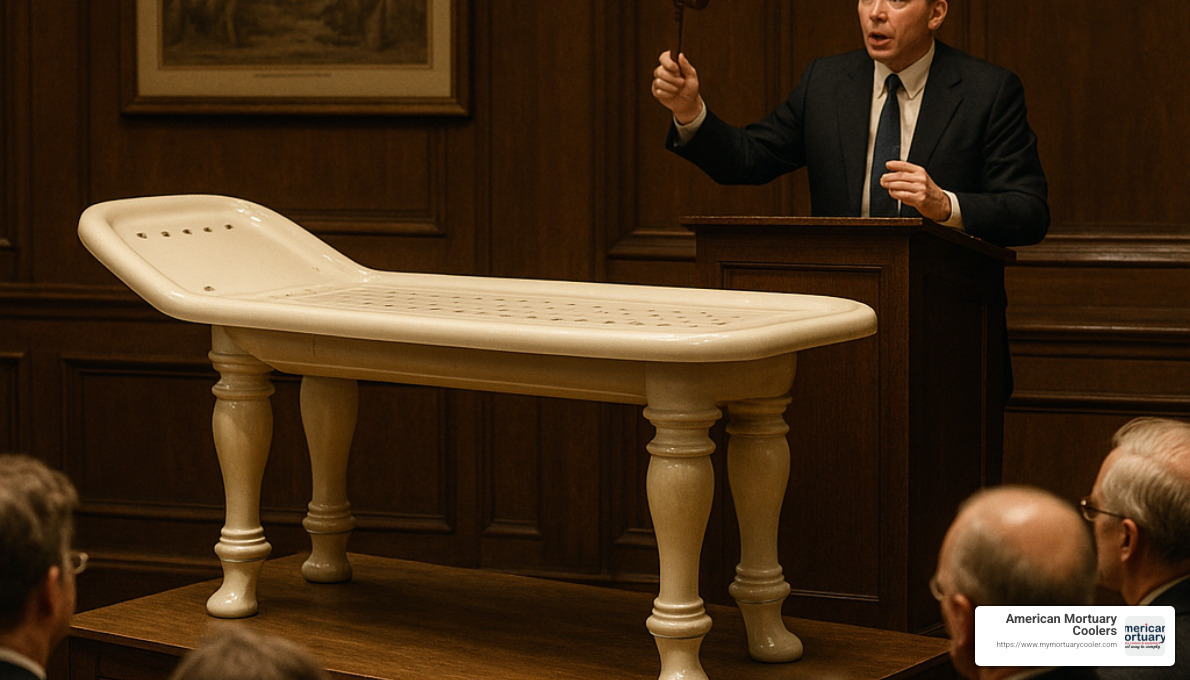
These tables are genuinely rare finds today. Many were simply discarded when funeral homes upgraded to stainless steel models in the 1950s. Their delicate porcelain surfaces meant many didn't survive the decades, and let's be honest – their weight makes them challenging to move around, limiting how far they traveled from their original locations.
As James Edmonson, curator emeritus at the Dittrick Medical History Center, puts it: "These tables represent a fascinating intersection of medical history, industrial design, and funeral culture. Their rarity continues to increase as surviving examples are acquired by museums and serious collectors."
If you're tracking recent sales (as we do at American Mortuary Coolers), you'll notice quite a range in pricing. A Royal Doulton Post Mortem Table from the 1920s recently sold for around $800, representing an entry-level price for a piece needing some TLC. On the other hand, a fully restored Dodge Chemical Co. hydraulic table from the 1930s fetched $2,750 at a specialized auction. Victorian-era portable designs tend to command premium prices, with one recently listed at $895.
Finding these historical gems requires some detective work. Your best bets include specialized medical and funeral antique dealers, estate sales of closed funeral homes, and architectural salvage businesses. Online platforms like eBay and Etsy occasionally list them, though buyer beware – authentication can be challenging online. Auction houses with medical or scientific divisions often have the most carefully vetted examples.
Now, a word of caution about shipping these beauties. Having spent years shipping modern mortuary equipment across the country, we've learned a thing or two about transporting heavy, delicate items. These tables are extraordinarily heavy yet have fragile porcelain surfaces – a challenging combination! Whenever possible, inspect in person and arrange local pickup. If shipping is necessary, invest in professional crating with custom foam supports and insurance that specifically mentions the porcelain components. We always recommend using freight carriers experienced with antique medical equipment and delivering directly to where the table will ultimately live.
Current Market Values
When it comes to pricing antique porcelain embalming tables, there's quite a spectrum based on condition, maker, and features.
Entry-level pieces typically range from $800-$1,200. These are usually tables that need significant restoration work, have noticeable porcelain damage, come from lesser-known manufacturers, or are missing important components like drainage fixtures. They're perfect for the handy collector who enjoys restoration projects.
Mid-grade examples ($1,500-$2,500) represent the sweet spot for many collectors. These tables are in good working condition with only minor porcelain damage or professional repairs. They typically have complete drainage systems, come from known manufacturers, and might include some documentation of their history.
For the serious collector, museum-quality pieces start around $3,000 and can go significantly higher. These rare beauties boast pristine original condition, come from prestigious makers like Royal Doulton or early Dodge Chemical, and include all original components. They often have documented historical significance or rare features that set them apart.
What drives these values? Completeness is crucial – original drainage fixtures, hardware, and mechanical components significantly boost worth. Condition matters tremendously, particularly the integrity of the porcelain surface. Provenance that links a table to a specific funeral establishment adds a premium, while rarity in design or production date commands higher prices. Finally, aesthetics play a role – ornate Victorian and Art Deco styling generally attracts premium prices.
We've noticed an interesting trend at American Mortuary Coolers – interior designers and film production companies have developed a growing interest in these pieces, creating demand beyond traditional collectors. This new market has helped drive price increases of about 15-20% over the past five years. In fact, one of our tables was recently featured in Apple TV's "Bad Monkey" starring Vince Vaughn, showcasing how these historical pieces find new life in american mortuary tables on Bad Monkey set.
Ethical & Cultural Considerations
Collecting antique porcelain embalming tables comes with responsibilities that go beyond typical antiques. These were, after all, tools designed for a solemn purpose.
Respectful display matters. Many collectors repurpose these pieces as library tables or display surfaces while acknowledging their original function. There's no need to hide what they were, but sensitivity goes a long way. A thoughtful approach honors the craftsmanship while respecting the table's history.
When displaying in shared spaces, consider your audience. Not everyone is comfortable around items with mortuary origins. Providing appropriate context and educational information helps visitors appreciate these artifacts for their historical significance rather than focusing solely on their somewhat macabre origins.
There's also the legal side to consider. While the tables themselves rarely face restrictions, shipping them across state lines or international borders might trigger regulations related to medical antiques. We always recommend checking with a specialist before planning international shipping.
If your table came with documentation linking it to specific individuals or funeral homes, consider privacy implications. Many collectors maintain these records privately rather than displaying them publicly – a small gesture of respect for those who may have been served on the table.
As one museum curator beautifully expressed: "These artifacts tell important stories about how our society has cared for the dead. Collecting them preserves this history, but carries a responsibility to honor their original purpose."
For more detailed guidance on navigating the collector's market, check out our Antique Embalming Tables: A Collector's Buying Guide or browse antique and vintage options to see examples of what's currently available.
Care, Restoration & Display
Preserving an antique porcelain embalming table requires a special touch and understanding of these unique historical pieces. After all, these aren't your typical antiques - they're a fascinating blend of industrial craftsmanship and medical history that deserve thoughtful care.
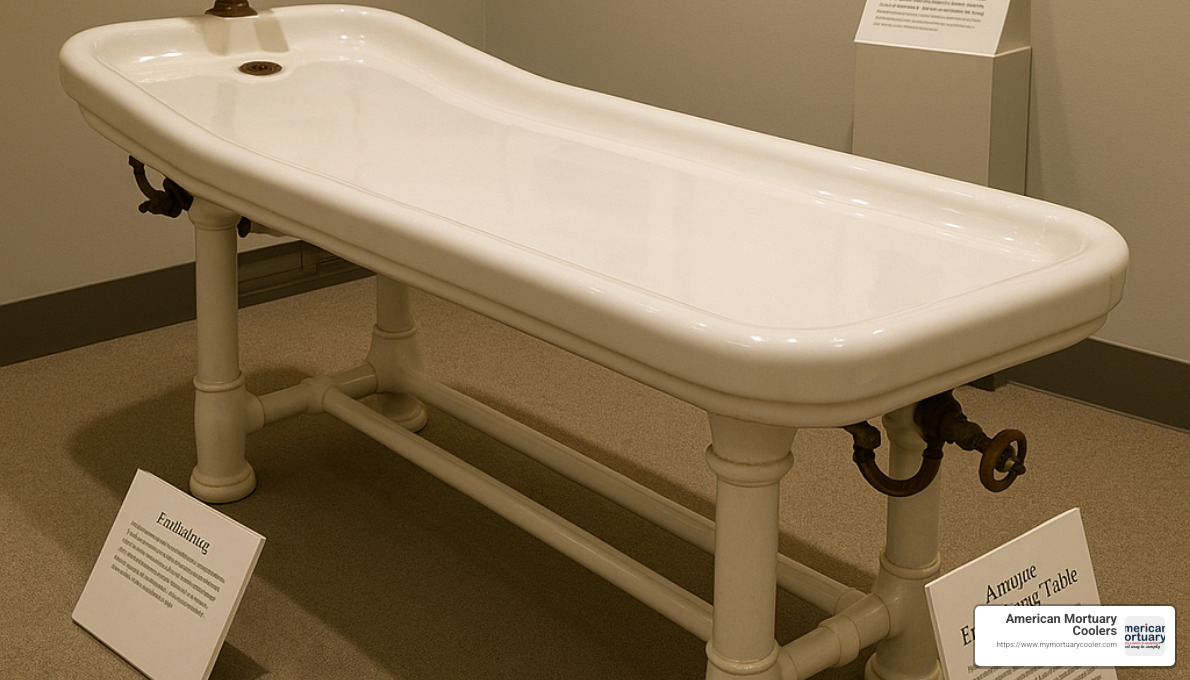
When it comes to cleaning these beauties, gentleness is key. The porcelain surfaces that give these tables their distinctive character should only be cleaned with mild, non-abrasive products. I've seen too many well-intentioned collectors damage historic pieces with harsh chemicals or scrubbers. Instead, opt for soft cloths and neutral cleaners, paying special attention to those drainage channels where residue loves to hide.
The cast iron components need their own special attention too. A good metal-specific product will keep the base looking its best without compromising its integrity. These tables were built to last, but even the sturdiest materials need proper care.
For those inevitable porcelain imperfections that come with age, you have options. Small hairline cracks can often be stabilized with specialized porcelain epoxies, while chips might benefit from color-matched repair compounds. However, I always advise collectors to document the original condition before attempting any repairs. Sometimes, those marks of age tell their own story and add to the piece's character and authenticity.
Rust prevention is another crucial aspect of preservation. These tables usually feature significant metal components that are vulnerable to oxidation. Applying appropriate protective coatings, maintaining consistent humidity levels between 40-50%, and keeping the table off bare concrete floors can make a world of difference. I recommend regular inspections to catch any early signs of rust before they become serious problems.
When it comes to displaying your antique porcelain embalming table, thoughtful placement matters. Direct sunlight is the enemy of preservation, potentially causing fading and damage to the porcelain over time. The substantial weight of these tables also requires even support to prevent stress on joining points. Many serious collectors invest in custom mounts that properly distribute weight.
One of the most rewarding aspects of collecting these pieces is finding creative ways to repurpose them while honoring their history. With a custom glass top, they can become striking library or reading tables. I've seen beautiful examples transformed into unique kitchen islands (with appropriate sealing, of course) or showcased as architectural focal points in historical settings. The key is finding that balance between practical use and respectful acknowledgment of the piece's original purpose.
At American Mortuary Coolers, we've had the privilege of helping museums and private collectors develop conservation plans that preserve these artifacts for future generations. Our experience with modern mortuary equipment gives us unique insight into the engineering principles behind these historical treasures.
DIY vs Professional Restoration
When facing restoration decisions for your antique porcelain embalming table, it's important to know your limits. Some tasks are perfectly suitable for a careful DIY approach, while others demand professional expertise.
Basic cleaning, minor rust removal from non-structural parts, and simple hardware replacement using period-appropriate pieces are generally safe for knowledgeable collectors to tackle themselves. Documentation and research are also valuable DIY activities that improve your connection to the piece without risking damage.
However, certain restoration challenges should be left to the professionals. Hairline crack repair in porcelain surfaces requires specialized knowledge and materials. Enamel re-firing or major porcelain repairs demand expertise that most collectors simply don't have. And when it comes to hydraulic system rebuilding or structural repairs to cast iron components, professional intervention isn't just preferable—it's essential.
"The most common mistake we see is inappropriate DIY repairs using modern materials that damage the historical integrity," shared restoration specialist Eleanor Rigby in a recent consultation. "Porcelain requires specialized knowledge—when in doubt, consult a professional with experience in medical antiques."
The cost-benefit analysis is worth considering too. Minor professional restoration typically ranges from $300-$800, while major porcelain work can exceed $1,500. Complete hydraulic system rebuilding often costs $500-$1,200. These investments might seem substantial, but for rare or historically significant pieces, professional restoration often pays dividends in both preservation and value.
For tables destined for working display in museums, we always recommend professional assessment of structural integrity and careful testing of weight-bearing capacity before installation. There's nothing worse than damage caused by well-intentioned but inadequate preparation.
Long-Term Preservation Tips
The journey of preserving your antique porcelain embalming table doesn't end with restoration—it requires ongoing attention to ensure its longevity.
Environmental control plays a crucial role in preservation. Maintaining stable temperature and humidity levels prevents stress on both porcelain and metal components. Keep your table away from UV light sources, which can degrade materials over time, and avoid placing it near heat sources that cause expansion and contraction.
Proper handling is equally important. Always lift from the base, never by the more fragile porcelain components. When moving your table, use padded moving blankets and enlist multiple helpers—these pieces are deceptively heavy and awkward to maneuver. If you need to disassemble components for a move, document the process carefully to ensure proper reassembly.
We recommend establishing regular maintenance routines. Quarterly inspections allow you to catch new damage or deterioration early. Check drainage fixtures for stability, inspect metal components for oxidation, and verify the structural integrity of all load-bearing elements. These simple check-ups can prevent minor issues from becoming major problems.
Don't underestimate the value of good documentation. Maintain detailed photographs of all aspects of your table, record any restoration work performed, and preserve provenance documents that tell its story. Consider creating a condition report that can accompany the piece if it ever changes hands. This documentation not only improves the historical value but provides crucial information for future conservation efforts.
At American Mortuary Coolers, we've seen how environmental factors significantly impact long-term preservation across different regions of the United States—from our Johnson City, TN headquarters to the varied climates of the Northeast, Midwest, and Pacific regions we serve. That's why we recommend creating a comprehensive preservation plan custom to your specific conditions.
With proper care and respect for its historical significance, your antique porcelain embalming table can remain a fascinating conversation piece and important historical artifact for generations to come. These unique pieces of our collective past deserve nothing less than our best stewardship.
Frequently Asked Questions about Antique Porcelain Embalming Tables
Why choose porcelain over wood or steel?
When funeral professionals needed reliable equipment in the early 20th century, antique porcelain embalming tables stood out as the premium choice for good reasons.
The porcelain surface solved a major problem that wooden tables couldn't – absorption. Unlike wood, which would soak up fluids and chemicals like a sponge, porcelain remained completely non-porous. This meant no lingering odors, no bacterial growth in the grain, and a surface you could actually get truly clean between uses.
"I've spoken with embalmers from that era who would tell you they'd never go back to wooden tables once they experienced porcelain," says Tom Hadley, our restoration specialist at American Mortuary Coolers. "The peace of mind alone was worth the investment."
Compared to steel options, porcelain offered remarkable chemical resistance. Those early formaldehyde compounds were harsh – they'd eventually pit and damage steel surfaces, while porcelain shrugged them off year after year. The porcelain surface also maintained a more stable temperature, which mattered tremendously in buildings without modern climate control.
There was another practical advantage that advertisements of the era frequently mentioned. As one 1920s catalog eloquently put it: "The superior white porcelain surface provides an ideal background for the embalmer's art, allowing for precise visual assessment of the deceased's condition." This improved visibility helped professionals achieve better results when cosmetic restoration was needed.
How do I verify a table's age and maker?
Authenticating an antique porcelain embalming table requires detective work, but the process can be fascinating. Here's how to approach it:
Start by examining the construction techniques. Pre-1920 tables typically feature more handcrafted elements – slight irregularities in the porcelain application, less standardized dimensions, and more individualized casting marks. If everything looks machine-perfect and identical, you're likely looking at a later model.
The materials themselves tell stories too. Early porcelain has distinctive firing characteristics visible under magnification – tiny bubbles and subtle color variations that modern manufacturing methods have eliminated. The way the porcelain bonds to the metal substrate also develops specific aging patterns that are nearly impossible to fake convincingly.
Maker's marks are your best friends in this process. While some have worn away over decades, many tables retain subtle identifying stamps or plates. The Funeral Service Foundation maintains historical records that can help identify even obscure manufacturers. We've helped collectors match partial marks to complete catalog entries many times.
Hardware components, especially drainage fixtures, evolved significantly over the decades. Original brass fixtures develop a distinctive patination that's consistent with genuine age – a warm, slightly mottled appearance that modern reproductions rarely capture accurately.
When in doubt, consider consulting specialists. Organizations like the National Museum of Funeral History offer authentication services for significant pieces. At American Mortuary Coolers, we maintain an extensive archive of historical catalogs and specifications that allows us to verify manufacturing details across multiple eras.
Can these tables still be used for modern embalming?
While you theoretically could use an antique porcelain embalming table for modern procedures, I generally advise collectors against it – and not just because I'm in the business of selling new equipment!
First, there's the regulatory reality. Today's funeral establishments must meet strict OSHA and state-specific regulations for preparation room equipment. Most antique tables simply don't comply with current standards for bloodborne pathogen control, drainage containment, and workplace safety.
From a practical standpoint, contemporary embalming techniques have evolved to require features that weren't built into these vintage pieces – specialized drainage systems, height adjustability for ergonomic working positions, and compatibility with modern instruments.
There's also the preservation angle to consider. These tables are becoming increasingly rare historical artifacts. Active use would accelerate deterioration of the porcelain surface and mechanical components, potentially damaging a piece of funeral history that can never be replaced.
"I had a customer who wanted to use his grandfather's porcelain table in his new funeral home," recalls Sarah, our customer service manager. "After discussing the options, he decided to display it in his arrangement room as a conversation piece and ordered a modern system for actual preparations. He tells me families love seeing that connection to funeral service history."
If you're drawn to the classic aesthetic while needing modern functionality, we at American Mortuary Coolers can design custom tables that incorporate historical design elements while meeting all current regulations. It's the best of both worlds – timeless appearance with contemporary performance.
Conclusion
The antique porcelain embalming table represents far more than just a piece of funeral equipment—it's a physical connection to our past and how we've cared for our loved ones through history. These remarkable artifacts tell the story of how American funeral practices evolved from informal, home-based rituals to the professional industry we know today.
For collectors and history enthusiasts, these tables offer something truly special. They combine beautiful craftsmanship, historical significance, and increasing rarity in a way few other antiques can match. What started as purely functional equipment has found new appreciation among interior designers, museum curators, and medical historians who recognize their unique cultural value.
"These tables silently witnessed the change of death care in America," as funeral historian Patricia Moreland once told me. "Each one preserves stories of how families and communities honored their dead—stories that might otherwise fade from memory."
At American Mortuary Coolers, we find ourselves in a unique position—bridging the gap between historical appreciation and modern funeral service. Our nationwide reach allows us to connect with collectors and funeral professionals from Portland to Miami, Seattle to Boston. We regularly help museums accurately display these pieces and advise private collectors on authentication and preservation.
Whether you're a dedicated collector with multiple pieces, a museum curator planning an exhibition, or simply someone fascinated by this unique intersection of medical and funeral history, we encourage you to explore the remarkable craftsmanship and cultural significance of the antique porcelain embalming table. Each one has stories to tell about our relationship with mortality and how we've cared for each other at life's end.
For those who appreciate the classic aesthetics of these historical pieces but need modern functionality, we invite you to explore our custom mortuary solutions. We're proud to deliver our handcrafted equipment directly to funeral homes across all 48 contiguous states, combining traditional craftsmanship with contemporary standards.
The legacy of these tables lives on—both in carefully preserved antiques and in the thoughtfully designed modern equipment that continues to serve families during their most difficult moments.
















